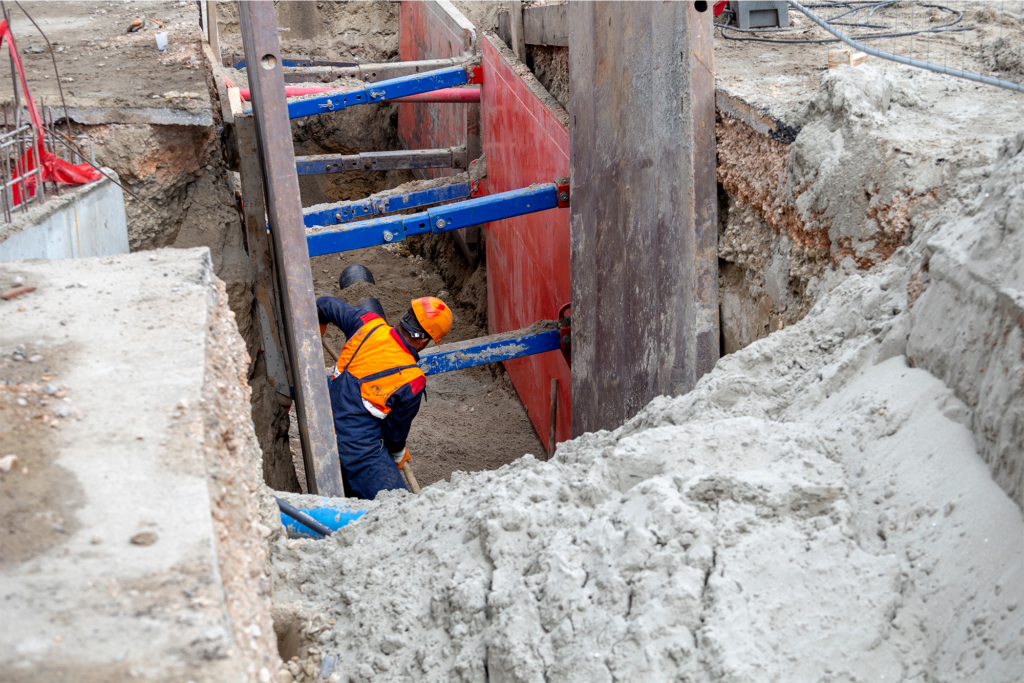Trenching and Excavating Safety

On average, two workers are killed every month in trench collapses. At it is our responsibility to provide a safe workplace, free of recognized hazards that may cause serious injury or death. By instituting safe work practices and procedures while excavating and working in trenches, we can prevent needless worksite injuries.
Defining an Excavation and Trench
An excavation is any man-made cut, cavity, trench or depression in an earth surface formed by earth removal.
Trench (trench excavation) refers to a narrow excavation (in relation to its length) made below the surface of the ground. In general, the depth is greater than the width, but the width of a trench (measured at the bottom) is not greater than 15 feet (4.6 meters).
Dangers of Trenching and Excavation
Cave-ins pose the greatest risk and are much more likely to result in worker fatalities than any other excavation-related accidents. Other potential hazards include falls, falling loads, hazardous atmospheres and incidents involving mobile equipment. One cubic yard of soil can weigh as much as a car. An unprotected trench is an early grave. Do not enter an unprotected trench.
Trench Safety Measures
Trenches 5 feet (1.5 meters) deep or greater require a protective system unless the excavation is made entirely in stable rock. If the trench is less than 5 feet deep, a competent person may determine that a protective system is not required.
Trenches 20 feet (6.1 meters) deep or greater require that the protective system be designed by a registered professional engineer or be based on tabulated data prepared and/or approved by a registered professional engineer.
Daily Inspections
In accordance with OSHA standards, trenches need to be inspected daily before work begins, or whenever conditions change, by a competent person to ensure elimination of excavation hazards.
A competent person is an individual who is capable of identifying existing and predictable hazards or working conditions that are hazardous, unsanitary, or dangerous to workers, soil types and protective systems required, and who is authorized to take prompt corrective measures to eliminate these hazards and conditions. Check with your supervisor at the beginning of each shift to make sure any trenches you will be working in have been properly inspected and are safe for entry.
Access and Egress
OSHA standards require safe access and egress to all excavations, including ladders, steps, ramps or other safe means of exit for employees working in trench excavations 4 feet (1.22 meters) or deeper. These devices must be located within 25 feet (7.6 meters) of employees at all times.
General Trenching and Excavation Rules
Keep heavy equipment away from trench edges.
Identify other sources that might affect trench stability.
Keep excavated soil (spoils) and other materials at least 2 feet (0.6 meters) from trench edges.
Know where underground utilities are located before digging.
Test for atmospheric hazards such as low oxygen, hazardous fumes and toxic gases when > 4 feet deep.
Inspect trenches at the start of each shift.
Inspect trenches following a rainstorm or other water intrusion.
Do not work under suspended or raised loads and materials.
Inspect trenches after any occurrence that could have changed conditions in the trench.
Ensure that personnel wear high visibility or other suitable clothing when exposed to vehicular traffic.
Protective Systems
There are different types of protective systems.
Benching means a method of protecting workers from cave-ins by excavating the sides of an excavation to form one or a series of horizontal levels or steps, usually with vertical or near vertical surfaces between levels. Benching cannot be done in Type C soil.
Sloping involves cutting back the trench wall at an angle inclined away from the excavation.
Shoring requires installing aluminum hydraulic or other types of supports to prevent soil movement and cave-ins.
Shielding protects workers by using trench boxes or other types of supports to prevent soil cave-ins. Designing a protective system can be complex because you must consider many factors: soil classification, depth of cut, water content of soil, changes caused by weather or climate, surcharge loads (e.g., spoil, other materials to be used in the trench) and other operations in the vicinity.
For more risk management resources, contact INSURICA today.
This is not intended to be exhaustive nor should any discussion or opinions be construed as legal advice. Readers should contact legal counsel or an insurance professional for appropriate advice. ©2024 Zywave, Inc. All rights reserved
Source: OSHA Fact Sheet: Trenching and Excavation Safety, Occupational Safety and Health Administration







